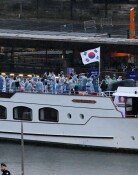To Add Insult to Injury. Riots One After Another in China
To Add Insult to Injury. Riots One After Another in China
Posted May. 06, 2003 22:11,
Residents who oppose to strict SARS prevention measures of the Chinese government are demonstrating and rioting one after another while severe acute respiratory syndrome (SARS) are still prevailing in China on Tuesday. In addition, SARS patients are facing with new difficulty in getting astronomical figures of their treatment cost besides struggling with SARS.
1,000 residents of Yuhwan, Zhejiang Province, who became furious of their town being designated as a SARS detention center stormed into government buildings, damaged office fixtures and set fire in the buildings. Some of the residents were detained.
Also in Linzhou, a central city of Henan province in China, residents rooted and demonstrated against medical facilities and opening a new SARS patient detention center which were planned to open between April 25~28 in their district. 13 people were arrested because of it.
Meanwhile, in Beijing, now the new cases of infection reduced to two digits a day, but even though the spread of SARS seems to be controlled slightly, the situation still remains grave, Chinese Premier Wen Jiabao emphasized.
Beijing City has begun to develop a computerized map that can monitor the movement of SARS patients and identify residents who could be exposed to SARS virus to prevent the spread of SARS.
According to medical staff of Guangdong province, a general SARS patient need 100,000 yuan (about 15 million won) to pay for his or her medical costs; During the treatment period which last 2~3 weeks, one needs to pay 5,000 yuan (about 0.75 million won) a day for antibiotics and other costs, and during the another month of the recovery period, one needs to pay 100~200 yuan (about 15,000 ~30,000 won).
Those patients who are severely infected of SARS accounting 10 percent of the total cases will get a bill of 1 million yuan (about 150 million won) for the total cost of the medical costs.
In China, about 8,500 SARS patients were reported to be being treated on May 5 (4280 cases of infection, 1433 discharged people after treatment, 2604 suspected SARS patients, and 206 were dead during the treatment).
Chinese government has made a budget of 2 billion yuan for SARS treatment, yet as most of the money is spent on disinfection, prevention of SARS, the burden of medical costs is on individuals.
However, considering the average income of a Chinese 2,000 yuan a month, SARS patients are out of their capacity to pay the treatment which amounts to 100,000 yuan on average even after they get assistance from various insurance careers. Hence, once SARS is controlled, it seems that individuals, various insurance companies and hospitals will go bankrupt.
I believe that SARS can be fully controlled and eradicated, said doctor Mike Ryan of the WTO who is in charge of coordinating international monitoring systems. The WTO has experience of controlling 900 new infectious diseases in the last several years and its staff have a good sense of predicting the possibility of controlling diseases.
In the meantime, research institutes such as Merck & Co Inc of U.S. have showed a progress in developing vaccine for SARS, so animal test will be able to be conducted in 2~3 months, the Wall Street Journal reported.
Yoo-Sung Hwang yshwang@donga.com







